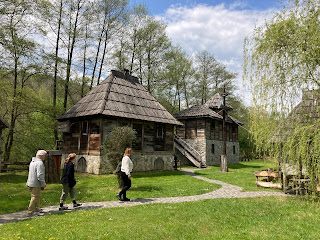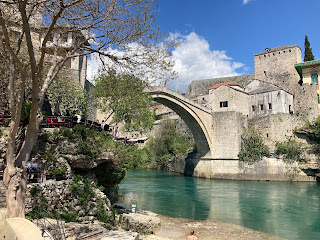This morning we bid farewell to Sarajevo. What a strange, sad city! The pall of war still hangs over it after 30 years, yet it strives to move forward. And the shadow of another conflict lurks nearby.
One thing we noticed while visiting was the trams -- all different, and all antiques. On the way out of town we passed the tram garage, and got a good look at a batch of them. Most were donated by other cities around the world to replace those destroyed in the 1990s. Yet Sarajevo keeps them running.
We traveled north through low mountains covered with timber and many small villages tucked into the valleys. It reminded me of Appalachia, because so many of the villages were barely recovered from their post-war state.
In some places we passed huge factories from the Tito era of socialist Yugoslavia. Most of these sit idle now, rusting away slowly. Yugoslavia's industrial center is now Bosnia & Herzegovina's rust belt.
We made a rest stop at a sort of supermarket in a small town along the way. It was a cross between Walmart and Fleet-Farm. The restaurant/deli at the front of the store reaked with cigarette smoke, as smoking in bars and restaurants is not forbidden here. The store stocked a bit of everything, from auto parts to children's toys to groceries, wine, liquor, and beer. Stray dogs followed us through the parking lot, looking for handouts.
Later, we stopped for lunch at a rustic inn that had very good food, but the cabins they were renting, the playground for children, and the other buildings around the grounds were in terrible disrepair.
It took a while to cross the border. Leaving Bosnia took only minutes, but we waited behind a line of cars to enter Croatia once again. This is the southeastern edge of the European Union, and security is tighter here. We saw one car pulled aside and all contents pulled out for inspection. The luggage areas of our bus had to be opened and inspected, as well. That was a first.
Eastern Croatia is completely different terrain. Table-top flat and agricultural, it looked a lot like home. We drove on a modern, divided highway, but noticed that the tolls were quite high. That may have accounted for the lack of traffic. It also seemed like there was a rest area every 10 miles or so, with literally no vehicles using them.
We got off the beaten track a bit to get to the village of Karanac. This small town was established during Austrian-Hungarian Empire, and it follows a very orderly city plan duplicated in countless other villages in the region. Houses are neatly lined up on both sides of streets with sewage/drainage ditches on both sides of the road. A small walking bridge crosses the ditch for each house.
Each city lot is long and narrow, with the house at the street, a barn attached behind the house, and about an acre of land for a garden stretched out behind.
The house in which we are staying was built in 1905 by the great-grandfather of the current owner. He and his wife and son operate this house, and another just a few doors down, as a sort of living history tourist inn. Everything is based on the 1905 model, with the old woodwork, doors, furnishings, etc. Of course, bathrooms and electricity have been added. The wi-fi here is very poor, but better than it was 100 years ago!
We were welcomed with a shot of rakija -- the traditional Croatian brandy. It is usually made from grapes, berries, or some other fruit. It is distilled clear, and the alcohol content is about 80 proof. But it is smoother than vodka or most other clear liquors. Then we were served a "snack" of huge donuts with apricot topping, freshly made by the wife.
After settling into our rooms, we returned to the dining room where a neighbor woman came to give a demonstration of cheesemaking. It took about an hour to make "young cheese" that we will have for breakfast tomorrow morning.
We then divided into two groups for another home-hosted meal (the second in as many days). Our group walked down the block with the cheesemaker. The meal was wonderful and the family delightful. Her father and son joined us for the meal. The father makes rakija and kept pouring!




















































